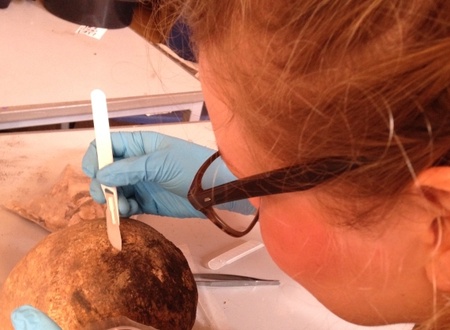University of Aberdeen archaeologists are part of a pioneering international research team exploring the significant role women have played in historical artistic work.
The project Word of Mouth: Embodied Stories of Premodern Women at Work, will explore the role of women in the spiritual, intellectual, artistic, social, and economic landscapes of medieval and early modern society.
We have all marvelled at archaeological and artistic masterpieces from the past, but the people behind them often remain invisible, especially women.
Now the project, led by Alison Beach, Professor of Medieval History from the School of History at the University of St Andrews and supported by a £1.5m funding boost by the Arts and Humanities Research Council (AHRC), will push the boundaries within which archaeologists and historians can track the invisible workforce of the past.
The international team of historians and archaeological scientists from University College Dublin, and the Universities of Aberdeen and Turin in Italy, will focus on the period between the eleventh and seventeenth centuries, and build on research which began with the discovery in 2019 of lapis lazuli pigment in the mouth of a religious woman buried in medieval Germany.
Lapis lazuli was one of the rarest and most expensive artistic materials in the Middle Ages, with very few highly skilled artists entrusted with its use in decorating only the most valuable religious items. In 2019, during an investigation of health and diets in the Middle Ages at a medieval German monastery, International Co-Lead Dr Anita Radini, now at University College Dublin, discovered pigment flecks in the mouth of a medieval nun who had lived between 997 and 1162AD. The pigment is believed to have been lodged in the woman’s teeth as she used her tongue to shape the end of a paintbrush.
The extraordinary discovery indicated that women had played a more significant role in artistic work than had been reflected in historical records, and contributed to the growing volume of evidence which challenges exclusionary narratives about the nature and scope of medieval and premodern women’s artistic and economic activities.
Professor Beach, Dr Radini and the international team will build on this discovery in a 5-year project that will look in depth at the lives of over 300 premodern female skeletons from Germany, Italy, England, and Iberia through analysis of their skeletons. Moving between the library and laboratory, the team will integrate historical research with cutting-edge analysis of human remains, experimental archaeology, and materials analysis (the study of archaeological and historical artefacts), to provide novel and nuanced insights into these women’s lived experiences.
Bioarchaeological analysis, which includes the physical, chemical and biomolecular examination of skeletons, will discern the physical traces left by craft and skilled artistic labour from those left by religious labour, such as extensive kneeling in prayer. Chemical analysis bones and teeth will reveal the past dietary habits, and even childhood origins of the women studied. These analyses will be used to produce enhanced osteobiographies, life stories of individuals as told by their skeleton.
The osteobiographies will be synthesised with textual analysis to establish a greater understanding of the activities in which women participated, and of the impact of this participation on women’s bodies and health. The researchers will also consider the socio-cultural determinants of the women’s participation in different types of labour, using evidence to evaluate social inequality among religious women.
“This project brings together a team of top historians and archaeological scientists to open new windows on the lives of medieval women who have been lost to history,” says Primary Investigator Alison I. Beach of the University of St Andrews.
Professor Kate Britton from the University of Aberdeen who, along with specialist technician Dr Orsolya Czére also at Aberdeen, will lead the isotope (chemical) research said: “We’re so excited to get started on this project. Isotope analysis provides a window into the lives people led hundreds of years ago – the choices they made, and even where they came from. We’ll use different methods to understand the types of foods these women regularly consumed, and to identify individuals who may have died and been buried far away from where they grew up.”
Dr Czére, whose doctoral research focused on using isotope analysis to explore the lives of Medieval Scottish people, including friars in Aberdeen, added: “These methods allow us to examine individual diet and mobility during late childhood, the teenage years, and into adulthood. Through this, we’ll witness the life-journeys of these women and gain crucial insights into the roles they played in, and how they were perceived by, their broader societies.”
“I think we are going to get some surprises” added Professor Britton, “Women’s stories from the past are most often told for them, portraying a very restricted view of their life-journeys. In this project we are going to let them tell their own stories.”
Dr Radini, International Co-Lead, states “I am truly delighted to be able to carry on with the work Alison and I started a few years back and to work with such a fantastic team! This project has true potential to change the way we look at the workforce in past societies, starting from women! I, too, cannot wait to start”.
Dr Rosa Boano and Professor Beatrice Demarchi of the University of Turin, who will lead the team in search of ancient biomolecules preserved in human remains, say that they are "delighted to be part of this fascinating journey of discovery of working women's lives across Europe."


